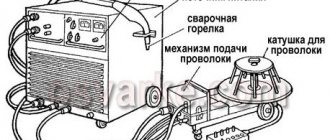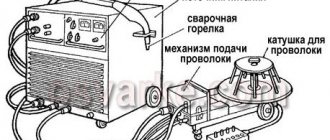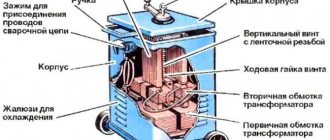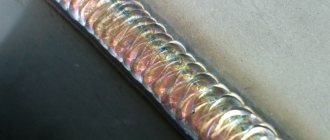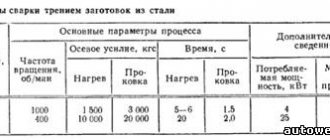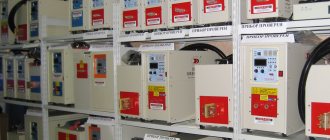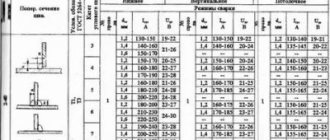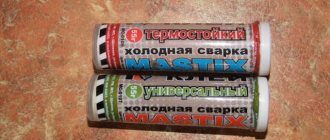Before welding, parts are placed in different spatial positions. One example is the fillet weld. The order of the process and the level of complexity of welding depend on its location relative to the horizon.
A corner connection is formed when parts are installed in the shape of the letter T, end-to-end or overlapping. It is found in most metal structures.
Fillet weld.
Fillet weld welding technology
When working with parts installed at an angle, use classic welding machines. You can use a simple transformer.
The disadvantage is the large size of the equipment. The best option is an inverter. Light weight and wide range of settings make it easier to work with complex seams.
When choosing a technology, take into account that:
- The current strength is set taking into account the diameter of the electrode and the thickness of the parts being connected. At a high value of the parameter, burns occur, at a low value, the rod sticks.
- A uniform, strong seam is obtained with oscillatory movements. Other methods of movement, such as zigzag, are acceptable.
- The ceiling seam is formed under conditions of rapid solidification of the melt. To do this, use a rod with a refractory coating, which is moved in a circular motion. This is not entirely convenient for the welder. As the electrode moves away, the arc weakens and the weld pool decreases. This results in a short circuit. This technology is complicated by overheating of the lower surfaces of the parts. Therefore, it is recommended to refuse it.
Types of welding seams
What types of welds are there? According to engineering design, all welding seams are divided into four main groups:
There are a number of types of welds depending on the type of connection:
- a butt joint seam, when two workpieces with straight ends are butted together and welded into a circular seam with an even seam;
- seam on a T-beam or I-beam. Often used in the production of iron piles or rails;
- overlapping joint seam, when one welded piece lies on top;
- a seam of connections that are located at an angle relative to each other.
Welding electrodes are the main consumables for most types of welding, but the most basic method with which welding work is carried out with electrodes is the electric arc welding method.
Welding machines of any kind, inverter or semi-automatic, are high-quality equipment, but sooner or later the time comes to repair it and remove any faults that have arisen. Read more about repairing welding machines.
Types of fillet welds (welding positions)
Compounds are classified according to many criteria. First of all, this is a method of installing blanks. Depending on the requirements for the strength of the finished structure, the seam is made one- or two-sided.
In the second case, the seam is reliable and holds its shape longer. When welding on one side, the structure may become deformed.
Lower
When working in this way, one part is in a horizontal position, the other in a vertical position. The seam is formed at a right angle between the surfaces.
If the thickness of the workpiece does not exceed 12 mm, cutting the edge is not required, but the lower part of the sheet installed perpendicularly is cut so that the distance between the edges is less than 2 mm. When working with thick parts, a V-shaped cut is made.
Example of a fillet weld.
Vertical and horizontal
When welding parts located vertically, the melt flows down. Reducing the arc length helps eliminate the formation of droplets; to do this, the electrode tip is brought closer to the area being treated.
If the rod does not stick, it can be rested against the part.
Seam welding has the following features:
Vertical welding seam and electrode movement pattern.
- The metal is prepared taking into account the type of connection and the thickness of the workpieces. The parts are secured in the desired position and short tacks are applied. This prevents the structure from moving during operation.
- The seam is formed both from bottom to top and in the opposite direction. The first method is considered more convenient. Under the influence of the arc, the weld pool moves upward. The seam is of better quality.
- Fillet welding can be carried out in a vertical position with arc separation. During the break, the melt has time to cool. In this case, the same movements of the electrode are used as when welding without separation: in different directions, in a circle or in a loop.
- When welding from top to bottom, the rod is installed at a right angle to the surface of the workpiece. After the arc is excited, the part is heated, the tip is released and welding is carried out in this position. The method is not entirely convenient, since it requires constant monitoring. However, the seam acquires the required characteristics.
Horizontal connections can also be formed in different directions. The method is chosen taking into account the preferences of the welder. The bath also moves downwards, so the angle of the electrode is increased, taking into account the welding speed and amperage.
As the melt drains, they make faster movements and periodically tear off the arc. During these breaks, the metal cools down and no drops form. You can try changing the voltage. These methods are used in stages.
We recommend reading: What are the types of defects in welds?
Horizontal weld seam.
Ceiling seams
This is the most difficult way to form compounds. It requires experience and constant monitoring of the treated area. During the welding process, the electrode is held perpendicular to the ceiling.
The arc length is minimal, the speed of movement is constant. The rod is moved in a circular motion, expanding the melting area.
Welding ceiling seams.
Into the boat
Corner joints often have to be welded on both sides. To carry out the process correctly, the workpieces are installed so that their planes are at the same angle. This method is called boat welding. This simplifies the selection of electrode movements and improves the quality of the seam.
Boat welding.
Fillet welds during welding. Distinctive features.
The fillet welding process is characterized by a number of distinctive features. Let's consider the most acceptable methods by which corner joints are welded.
If the seam plane is located at the bottom, then it is better to weld the parts using the “boat” method. This method will allow you to get the highest quality seam and is well suited for beginners in welding work. The product is placed in a V-shape, reminiscent of a boat, hence the name of the method.
When welding with a “boat”, the risk of the formation of such defects as undercutting edges or lack of penetration is practically reduced to zero.
However, such suitable conditions for creating a fillet weld are not always present. Often, at the point where metal products are connected by means of a “boat,” T-welds are formed in such a way that one of the surfaces is strictly in a vertical position, the other in a horizontal position.
In such a situation, it is not easy to obtain a high-quality connection, since the part may not be welded in the upper part of the corner and in the horizontal plane of the seam.
Undercuts may appear on a vertical plane. The cause of their occurrence may be molten metal flowing down.
In order to avoid the occurrence of the above defects, it is important to move the electrode along the welding line with light oscillating movements.
Advice! Wire the electrode using a single seam with an 8 mm leg.
To eliminate the risk of lack of penetration, the initiation of the welding arc should begin at a distance of 3-4 mm from the edge of the leg on the lower horizontal plane. Afterwards, the arc must be directed to the top point of the seam and held there. This way you will get a well-cooked part.
To obtain a high-quality and durable fillet weld, you need to strictly adhere to the sequence of actions. Any welding machine is suitable for creating a corner joint. Do not forget about safety precautions and perform welding work in a protective suit and mask.
Home>>Welding methods>>Manual arc welding>>Welding fillet welds
Welding fillet welds can be done in two ways. This is a method of welding with a vertical electrode (“in a boat”), we have already talked about it on the page “Welding seams in the lower position” and a method of welding with an inclined electrode. a fillet weld depends on the method chosen . The most technologically advanced and convenient welding of fillet welds is a vertical electrode.
Classification of seams
Connections are also classified according to the method of edge matching. They are T-shaped, overlapped, end-to-end or point.
We recommend that you read
Existing types of welded joints
Lap joint
This method is used when working with thin sheet metal. The seam is boiled on both sides so that moisture does not penetrate into it and rust does not appear.
When laying parts overlapping, choose the inclination of the electrode correctly, which should be from 15 to 45 degrees. This helps to get a strong, reliable seam.
When deflected upward or downward, the bulk of the melt is displaced. The strength of the connection decreases or a weld seam does not form at all.
Overlap welding.
With edges joining to one point
This method is used when working with sheet metal or pipe ends. The blanks are installed at a distance of 1-2 mm from each other and secured with clamps.
When welding, the gap is filled with melting wire. Thin sheets are welded without additional preparation (cleaning from rust is always mandatory).
When working with thick parts, make a double or single seam, the edges are cut in the following ways:
- The edges of workpieces 4-12 mm thick are processed using any method. One-sided cutting is considered convenient. Thick parts are cut in the shape of the letter V. U-shaped cutting is a more complex method, used less frequently. If there are increased requirements for the quality of the seam and a thickness of more than 8 mm, the edges are cleaned on both sides.
- When welding parts larger than 12 mm, a double connection is required. Such a layer of metal cannot be heated evenly on one side. The edges are cut off on both sides, forming something like the letter X. It is not advisable to use V- or U-shaped methods: a larger volume of melt will be required to fill the gaps. Electrode consumption increases, operating speed decreases.
If thick parts will be joined with one-sided cutting, the melt is applied in several approaches. Such seams are called multilayer.
T-joint
This method involves installation in the shape of the letter T. The connection is formed on both one and both sides.
Edge cutting is performed depending on the thickness of the parts:
- for values up to 4 mm, no treatment is required;
- if the thickness is 4-8 mm, make a double seam without cutting;
- a metal layer of 4-12 mm requires the formation of a single seam with one-sided cutting;
- When working with parts thicker than 12 mm, double-sided processing is required.
The fillet weld is considered a type of T-weld. When forming it, the same recommendations are followed: thin sheets are boiled without edge treatment. For greater thickness, remove part of one or both sides.
T-joint welding seams.
With or without edge cutting
Proper welding of corner joints requires careful preparation of the edges of the elements. Joints of thin parts do not require additional measures.
Welded seams with edge preparation.
When welding without cutting, traces of corrosion are removed by brushing the metal until it shines. The edges of products of medium thickness are beveled at an angle of 45° on the attachment plate.
The backing is necessary to retain the additive and increase the strength of the seam. When cutting on both sides, the edge cone is truncated. This protects the edges from sagging and burns.
Possible problems
The strength and quality of the seam will depend on how completely you can avoid the defects characteristic of this type of joint. The main flaws include the following:
- Undercuts. An electric arc contributes to their appearance. Traces of her “cunning” appear in the form of small depressions on the surface of metal products. When welding from below, the damaged area can be closed by welding filler material. You just need to hold the electrode longer. However, the technique for making a fillet weld is much more complex. It takes a lot of effort to fuse the additive onto the side surface. This is why fillet welds usually only have indentations on one side.
- Lack of penetration on seam sections. They are more common among those welders who still need to accumulate knowledge in the technology of producing fillet welds. This factor affects this: the worker, in order to fill the joint, moves the electrode tip too vigorously on both sides. But the molten mass, on the contrary, flows down them, and the goal - welding the suture root - remains unattainable.
- Incorrect leg. The quality of fillet weld welding here depends on the ability to determine the required voltage mode, and then control the electrode at the required speed, trying to keep it at the same level. Is the current insufficient? The electrode operates at low speed, and the leg will be excessively convex. It follows that the base metal has not melted sufficiently. Increased current and faster electrode speed? The leg will be concave.
- Oblique angle. Welding joints usually differ in the corresponding shape to the degree of angle. This is the difficulty - maintaining the exact dimensions. The quality of the design will be hopelessly damaged when the attachment plate suddenly develops a slope towards one of the sides.
- Uneven metal deposit on the joint sides. High t, the heaviness of the edges and the electrode provoke the molten iron mass to flow down and immediately to the sides. As a result, it may happen that the main part of the seam is located on the lower surface. The upper edge, only tacked by welding, is vulnerable to deformation. A little load and it fell apart.
- Other defects. They are represented by voids, holes, ubiquitous cracks, unpredictable fistulas and craters, and other foreign solid inclusions. They can make themselves known in the process.
Common problems
Novice welders often make mistakes that contribute to the occurrence of defects. Some significantly worsen the quality of the seam, others only affect aesthetic characteristics.
It is necessary to detect defects in a timely manner and eliminate them. The most common problems are uneven filling or differences in seam width. As you gain experience working with fillet welds, errors occur less frequently.
Lack of penetration at the connection point
The defect occurs when the joint is partially filled with melt. This requires timely correction, since the strength of the weld decreases.
We recommend reading: How to use electric welding yourself
The main reasons for lack of penetration are:
- low current setting;
- moving the electrode too quickly;
- improper cutting of edges of thick parts.
To eliminate lack of penetration, increase the power of the arc and reduce its length. If the parameters are selected correctly, the defect will not reoccur.
Example of lack of penetration of a connection point.
Uneven impact
This error is manifested by the formation of pores or sagging. The former are voids located linearly or chaotically, the latter are protruding areas of the melt. Both phenomena are unacceptable because they negatively affect the performance of the finished structure.
The appearance of pores is promoted by:
- improper protection of the weld pool, excessive consumption of inert gas;
- use of low-quality electrodes;
- exposure of the welding zone to wind, which deflects the gas cloud (oxygen in this case reacts with the melt);
- presence of traces of corrosion or dirt on parts;
- improper edge processing.
Sagging occurs when working with filler material due to incorrect selection of welding mode and parameters. These elements are not connected to the main part. It is recommended to remove them mechanically.
Pruning the area
The defect is a depression along the seam. Occurs with increased arc length. The weld pool expands, the temperature is not enough to warm up the edges of the workpieces. The metal immediately hardens, forming undercuts.
To eliminate the defect, reduce the arc length or increase the current.
During fillet welding, an undercut can also occur due to improper holding of the electrode. The melt flows down, causing a groove to appear. In this case, the power of the arc is reduced and shortened.
Welding seam defect.
Seam burn
The defect is a through hole.
Its appearance is facilitated by:
- too much current;
- slow guidance of the rod;
- increased distance between the edges of the part.
To eliminate the defect, select the correct operating parameters of the device and reapply the suture.
Cold and hot cracks
The second type of defects appears during the cooling stage of the metal. They are directed across or along the seam. Cold cracks occur on an already hardened seam when the structure experiences excessive loads.
Such defects lead to gradual destruction of the connection. To eliminate the defects, the seam must be re-formed. If there are a large number of cracks, the edges of the parts are cut off.
Cold cracks during welding.
Incorrect calculations
When choosing incorrect parameters for the operation of the device, different types of defects arise. The seam loses strength and becomes deformed.
The main causes of problems are considered to be:
- Incorrect leg. The quality of the welded joint depends on the correct choice of voltage and the speed of the electrode. The latter must be kept at the same level. If the current is insufficient, the rod operates at low speed, and the base metal does not melt well. At a high value of the parameter, the leg becomes concave and burns are formed.
- Oblique angle. It is quite difficult to install the parts in the desired position. The design loses the required qualities if the tilt of the attachment plate shifts to one of the sides.
Advantages and disadvantages
The fillet joint is strong and common, but it is important to note that the fillet weld is also complex and requires certain skills and experience. If the rules for welding fillet welds are not followed, defects will occur in the form
- burns (a through hole in the seam, the cause is high current, the electrode is held in one place, a large gap),
- fistulas (this is a tubular cavity in the weld. Formed due to short circuits of the electrode or sudden interruption of the arc, it can also be caused by the lack of good technological preparation of the parts being welded),
- undercuts (recesses formed due to incorrect welding technique, incorrect position of the electrode, which leads to a weakening of the cross-section),
- lack of penetration (arising due to current strength, high speed of electrode movement, poor-quality stripping, electrode displacement, etc.),
- sagging (dripping metal, also formed due to incorrect welding technique), etc.
By following the technology, all defects can be prevented and a reliable, durable connection can be obtained. An advantage will also be cost-effectiveness, obtaining structures of complex shapes and different thicknesses. The downside is also the danger of the process and deformation.
Electrode selection (table)
The diameter of the rod is selected taking into account the thickness of the workpieces being welded. The choice is also influenced by the position of the workpieces, the leg of the seam, the type of connection, and the method of cutting the edges.
The table will help you install the correct electrode.
| Workpiece thickness, mm | 1-2 | 3-5 | 4-10 | 12-24 | 30-60 |
| Rod diameter | 2-3 | 3-4 | 4-5 | 5-6 | 6-8 |
The values are approximate as they depend on many factors. For example, when working with ceiling seams, you should not use elements with a diameter of more than 4 mm. Such rods are not used for multi-pass welding either. This contributes to uneven welding of the edges.
The most optimal technology
The best method for welding corner joints is the “boat” method. This technology allows the arc to reach the root. In this case, you need to properly secure the workpieces. The angle between the welded edges must be straight.
Welding begins from the bottom, gradually moving the weld pool upward. Before cooking, you need to study the movement pattern of the rod. When parts are less than 1.4 cm thick, it is not necessary to bevel the edges. The edges of thicker pieces are cut off.
It is not always possible to install parts for boat welding correctly. When using a different technology, pay attention to the leg of the seam. When its length is up to 8 mm, a single-layer connection is made.
For larger sizes, the seam must be multi-pass. At the first stage, the root is boiled using a thin electrode. After this, the following passes are performed.
Welding seams in the lower position
When welding in the lower position, it is recommended to weld the seams towards themselves or from left to right. This approach will make it possible to better control the welding joint, monitor the state of the arc, and correctly move the electrode during welding.
It is necessary to weld the seams in the lower position with a slight overlay of the bead in both directions. In this case, the edges of the metal melt and expand, and the molten metals of the workpieces form a strong and reliable connection. After welding on one side, to strengthen the seam, the workpiece is turned over, cleaned, and welded on the opposite side.
You need to know that metal whose thickness is less than 8 mm can be welded in one pass, that is, in one layer. When the metal thickness is more than 8 mm, welding is carried out in at least two layers. In this case, the height of the first welding seam must be at least 3 mm. The first layer, as a rule, is performed with 3 mm electrodes, and subsequent layers with 4-5 mm electrodes.
About the specifics of the process in general
Before starting welding, you need to prepare the joints. They should form a right angle. One part is placed horizontally, the other – vertically.
We recommend reading: How welds are shown in the drawings
The edges of T-shaped structures require mandatory cutting. However, this step is skipped when working with lap seams. The connection is formed in the corners formed when metal sheets are placed on top of each other.
The classic fillet weld consists of two structural elements connected to each other. In this case, cutting off the end of one of them is required.
Cutting edges for butt joints.
Welding instructions
Welding of T-joints is carried out as follows:
- Prepare the equipment. Using special tables, current and voltage are set.
- Install the electrode. In one plane, the rod should tilt in the direction of its movement.
- Excites an electric arc. When using the argon-arc method, gas supply begins.
- Make small potholders. After they cool, the formation of a continuous connection begins.
- Start finishing the seam.
Cleaning welds
After completion of work, particles of metal, slag and scale remain on the surfaces. The seam protrudes slightly above the surface, which impairs the aesthetic qualities of the structure. Such defects are eliminated by stripping. The procedure is performed in stages. First of all, remove slag or scale with a hammer and chisel.
At the next stage, if necessary, level the treated area. In this case, use a grinder with a metal grinding attachment.
The abrasive grain size is selected taking into account the required surface smoothness. When welding soft metals, the weld is tinned: covered with tin solder.
Cleaning welds with burrs.
Important Features
When using some fillet welding methods, you need to take into account nuances that can complicate the work.
Working with a ceiling seam
Welding of such joints proceeds normally only when the metal quickly solidifies after melting. A similar requirement applies to the formation of vertical seams.
To speed up the cooling process of the metal, electrodes coated with a refractory composition are used. Circular movements are combined with straight movements. The ceiling method should be used only if welding in other positions is impossible.
Even with a slight distance of the rod from the treated area, the arc goes out because there is not enough energy to maintain it. Because of this, the metal cools down, the weld pool narrows, which contributes to a short circuit.
Bottom heating of the treated area can complicate the work. Particles of molten metal fall deep into the weld, reducing its strength.
Direction of electrode guidance in a gas environment
When using a protective substance, the method of moving the rod plays an important role. There are left and right options.
The difference between the directions lies in the following features:
- When moving the rod to the right, the visibility of the weld pool improves, which makes the penetration deeper and the arc more stable. In addition, the method minimizes the amount of splashes generated.
- When left-handed, the melt sprays out more often. The penetration is shallow. The visual overview of the treated area is not impaired. The left direction of the electrode helps clean the weld pool. This method is more effective when welding aluminum alloy workpieces.
Restricted areas
When installing pipelines, the welder is faced with working in hard-to-reach places. To solve the problem, special measures have been developed.
This applies to polypropylene products often used in everyday life. When installing new plastic elements, situations arise in which the installation conditions differ from normal ones.
In this case, special tools are used:
- welding soldering iron;
- a set of nozzles (the best option is Teflon products);
- pipe cutter included in the welding soldering iron kit;
- degreaser;
- a set of fittings and other auxiliary elements.
By melting with a soldering iron, it is possible to form any type of corner joint. Special nozzles are used to combine elements of different diameters.
Transmission welding
This method implies the absence of direct contact. In this case, welding begins with careful preparation of the place where the parts are combined.
The method can only be used for working with thick-walled pipes of medium diameter. This means cutting a chamfer at an angle of 65-70°. To fix the parts, a centralizer is used to prevent the workpieces from moving.
The gap in the lumen should be 2.5 mm. Taking this parameter into account, the diameter of the rod is selected. An electric arc apparatus, for example an inverter, is used for welding.

